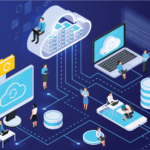Cloud computing is the computing resources provision on-demand over the Internet. Resources can be servers, storage systems, data networks, software, and platform services, Cloud service providers distribute computing resources among different customers.
The companies that offer these computing services are called cloud providers. They charge for cloud computing services based on usage.
Cloud computing has two meanings such as-
a) The most common refers to running workloads remotely over the internet in a commercial provider’s data center, also known as the “public cloud” model.
Popular public cloud offerings—such as Amazon Web Services (AWS), Salesforce’s CRM system, and Microsoft Azure—all exemplify this familiar notion of cloud computing.
b) The second meaning of cloud computing describes how it works: a virtual pool of resources, from raw, compute power to application functionality, available on demand.
When customers procure cloud services, the provider fulfills those requests using advanced automation rather than manual provisioning.
Cloud computing is usually classified on the basis of location, or on the service that the cloud is offering.
Learn more about What Cloud Computing Will Look Like In 2021
Based on a cloud location, we can classify the cloud as:
- Public Cloud – Whole computing infrastructure is located on the premises of a cloud computing company that offers the cloud service.
- Private Cloud – Hosting all your computing infrastructure yourself and is not shared. The security and control level is highest while using a private network.
- Hybrid Cloud – using both private and public clouds, depending on their purpose. You host your most important applications on your own servers to keep them more secure and secondary applications elsewhere.
- Community Cloud – A community cloud is shared between organizations with a common goal or that fit into a specific community (professional community, geographic community, etc.).
- Based on a service that the cloud is offering, we classify it as:
- IaaS (Infrastructure-as-a-Service)
- PaaS (Platform-as-a-Service)
- SaaS (Software-as-a-Service)
- or, Storage, Database, Information, Process, Application, Integration, Security, Management, Testing-as-a-service
History
The term “cloud computing” itself was coined in 1996 within a Compaq internal document. The term “cloud” was originally linked to the concept of distributed computing, which went mainstream at Apple-spawned General Magic in the early 1990s, with even earlier mentions in academic work before that.
Originally a military mainframe that was developed in 1950 to connect computer terminals across an internal matrix, non-local storage technology advanced quickly once it hit the scientific community.
This was an important consideration back at a time when computing had cost several million dollars and the need for multiple people to access the technology became a necessity.
Growth
Digital business transformation has entered a more challenging and urgency-driven phase due to the COVID-19 pandemic.
Global giants are providing customers with cost-effective and productive digital solutions as every industry is economically hard-hit by the pandemic.
The sudden shutdowns of offices, schools and enterprises have increased the demand for cloud solutions and services.
The cloud market in verticals such as IT, telecom, BFSI, and media, and entertainment has been impacted positively due to the work-from-home initiative.
Employees are using cloud collaboration platforms for communicating and consuming OTT streaming services heavily as they need to stay at home amidst the lockdown.
Benefits & risks
| BENEFIT: Data storage capacity | RISK: Implementation. |
| BENEFIT: Scalability of service. | RISK: Security dangers. |
| BENEFIT: Collaboration. | RISK: HIPAA compliance. |
| BENEFIT: AI and machine learning. | RISK: Availability and control. |
Future
The demand for cloud computing is growing every year. According to analytical agency Gartner, the global market for public cloud services will reach $ 308.5 billion in 2021. This is $ 40 billion more than in 2020 and 90 billion more than in 2019.
Gartner also notes that cloud computing has become a necessary catalyst for innovation for businesses. Analysts recommend that IT leaders continually adapt their IT strategy to suit the cloud.
According to the agency forecasts, in 2021, more than international companies’ half will apply an integrated cloud strategy, when the local infrastructure in their own data centers will expand and develop using cloud resources.
Hope this helps and gives a gist and fair idea about Cloud Computing.
For more details contact: info@manlitics.com





